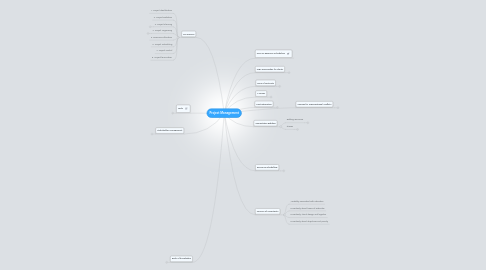
1. PM Process
1.1. 1. Project Identification
1.2. 2. Project Definition
1.3. 3. Project Planning
1.3.1. Project Execution Plan
1.3.1.1. Project Operating Plan
1.3.2. Operating Processes
1.3.2.1. Hierarchical Breakdown
1.3.2.2. Network Model
1.3.2.3. S Curves
1.3.3. Managerial Processes
1.3.3.1. Start-up
1.3.3.2. Planning
1.3.3.3. Monitoring
1.3.3.4. Reporting
1.3.3.5. Control
1.3.3.6. Close-out
1.4. 4. Project Organizing
1.4.1. Organization for Function
1.4.2. Organization for Projects
1.4.3. Matrix
1.5. 5. Resources allocation
1.6. 6. Project Scheduling
1.7. 7. Project control
1.8. 8. Project termination
2. Tools
2.1. Gantt Chart
2.2. Network Diagrams
2.3. Project Life Cycle
2.3.1. Phases
2.3.1.1. 1. Concept and initiation
2.3.1.2. 2. Design and Development
2.3.1.3. 3. Implementation / Construction
2.3.1.4. 4. Comissioning and Handover
2.3.2. Fast tracking
2.3.3. Added value vs cost to change across time
2.3.4. Level of effort across time
2.3.5. Level of detail
2.4. WBS
2.5. Project Charter
3. Body of knowledge
3.1. Integration Management
3.2. Scope Management
3.2.1. Main objectives
3.2.1.1. 1. Defining the Scope
3.2.1.2. 2. Controlling changes to the defined requirements of the project
3.2.1.3. 3. Managing Scope Creep
3.2.2. Phases
3.2.2.1. 1. Scope Planning
3.2.2.2. 2. Scope Definition
3.2.2.2.1. Scope Statement
3.2.2.2.2. Requirements
3.2.2.3. 3. Create WBS
3.2.2.3.1. 1. Take deliverables from project charter
3.2.2.3.2. 2. Decompose 1st level deliverables
3.2.2.3.3. 3. Check if there are missing deliverables
3.2.2.3.4. 4. Try to level the hierarchy
3.2.2.3.5. 5. Validate the WBS bottom-up
3.2.2.3.6. 6. Compare WBS with original project objectives
3.2.2.4. 4. Scope Verification
3.2.2.5. 5. Scope Control
3.3. Time Management
3.4. Cost Management
3.4.1. Cost estimating
3.4.1.1. Levels
3.4.1.1.1. Ballpark
3.4.1.1.2. Semi-Analytic
3.4.1.1.3. Analytic estimate
3.4.2. Cost Control
3.4.3. Estimate to finish
3.5. Quality Management
3.5.1. Planning
3.5.2. Assurance
3.5.3. Control
3.6. Risk Management
3.6.1. Risk Breakdrown Structure
3.6.2. Risk description
3.6.2.1. Probability
3.6.2.2. Impact severity
3.6.3. Mitigation actions
3.6.3.1. Prevention
3.6.3.2. Protection
3.7. Human Resource Management
3.8. Communication Management
3.9. Procurement Management
4. Competitive Bidding
4.1. Bidding resources
4.1.1. Management
4.1.2. Engineering
4.1.3. Economic estimate resources
4.1.4. Support activities
4.2. Phases
4.2.1. Planning
4.2.2. Organizational
4.2.3. Elaboration
4.2.4. Estimation
4.2.5. Revision & approval
4.2.6. Final editing phase
5. Stakeholder Management
5.1. Stakeholder attributes
5.1.1. Power
5.1.2. Legitimacy
5.1.3. Urgency
5.2. Classification
5.2.1. Latent
5.2.1.1. Dormant
5.2.1.2. Discretionary
5.2.1.3. Demanding
5.2.2. Expectant
5.2.2.1. Dominant
5.2.2.2. Dependant
5.2.2.3. Dangerous
5.2.3. Definitive
6. Type of contracts
6.1. Lump Sum
6.2. Unit Price
6.3. Reimbursable
7. Cost Estimation
7.1. Ballpark
7.2. Semi Analytic
7.3. Analytic
8. Sources for organizational conflicts
8.1. Resources
8.2. Objectives
8.3. Interdependencies
8.4. Command chain
9. S curves
9.1. Trapezoidal approx
9.2. Logistic Curve
9.3. Hermite Polynomials
9.4. Spline Curves
10. Resource schedulling
10.1. Priority rules
10.1.1. Minimum Total Float
10.1.2. Resource scheduling method
10.1.3. Min late finish time
10.1.4. Greatest resource demand
10.1.5. Greatest resource utilization
10.1.6. Shortest imminent operation
10.1.7. Most Job possible
10.2. Approach
10.2.1. Series
10.2.2. Parallel
